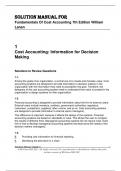Prüfung
SOLUTION MANUAL FOR Fundamentals Of Cost Accounting 7th Edition William Lanen 2024 / All Chapters A+
- Kurs
- Hochschule
SOLUTION MANUAL FOR Fundamentals Of Cost Accounting 7th Edition William Lanen 2024 / All Chapters A+ 1 Cost Accounting: Information for Decision Making Solutions to Review Questions 1-1. Among the goals of an organization, a central one is to create and increase value. Cost accounting system...
[ Mehr anzeigen ]



